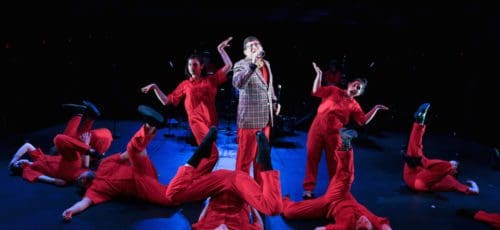Dance And (Healing) The Broken Body
Sarah Jordan has written extensively for national and regional magazines and newspapers. She is also the author of four books and a regular contributor to the Festival Blog.
How bad does it have to hurt to keep a dancer off the stage? Often, near catastrophically. Dancers, especially classically trained, continuously battle the limits of their bodies’ abilities to tolerate damaging physical repetition all for the sake of creating the illusion of effortless beauty on stage. Chances are that Georges Balanchine ballet that dazzled you with its speed, attack, and precise musicality, was performed by a dancer concealing a bum knee, murderously throbbing feet, and an aching back. Dancers are known for their high thresholds for pain and will push through most suffering, making physical accommodations to achieve the look they want and to perform their choreographic assignments. But there is a physical price they pay.
Dancers’ bodies require atypical strength, power, flexibility, agility, fine motor skills, and proprioceptive and kinesthetic awareness. Properly trained, rested, fueled, hydrated, and lucky, a dancer’s body will thrive season after season. But when hurt, dancers often wait until they are in significant pain before seeking help. And the line between temporary discomfort and career-ending pain can be blurry.
Many young classical dancers will push past the levels of their training to perform challenging choreography, and set themselves up for ticking time-bomb injuries. Forcing turnout (the rotation of their leg outward at the hip) beyond normal range can eventually cause stress fractures in the spine or knee issues; going on pointe without necessary foot and ankle strength can create tendonitis, stretched ligaments, and bone spurs; improperly strengthened lower abdominal muscles and hamstrings can lead to their own chain reaction of problems. Dancers dance through the pain for their art—and often for fear of losing work or being branded as a dancer who is “injury prone.” According to the US Department of Labor (Bureau of Labor Statistics), 90 percent of all dancers get injured.
But change is afoot for encouraging safer dance practices. I talked with three dance veterans to learn how attitudes towards dancing injured are evolving and messages of preventative wellness are being preached to younger dancers. New programs such as The University of the Art’s Body Pathways, the brain child of associate professor of dance Jennifer B. Johnson, is a powerful model for dancer education and preventive health care.
“It just seems obvious to me. Instead of rehab, I call this program ‘pre-hab,” jokes Johnson, a former dancer with Martha Graham Dance Company. Motivated to help young dancers avoid career-ending injuries before their careers even begin, Johnson created this multi-module program that includes components such as assessing (and correcting) the freshman class’s body imbalances and dance technique, and educating students about the value of proper nutrition, recovery time, and cross-training, as well as the study of kinestheology.
Johnson’s own experience with a debilitating dance injury and her teaching experiences during the last 12 years at The University of the Arts inspired her to create this program.
“My pain got so bad, I couldn’t sleep unless I floated in my bath tub. It was really dangerous, but it was the only way I could sleep,” recalls Johnson about the herniated and ruptured discs in her neck, and nerve damage in her right arm.
“I couldn’t even hold a coffee cup. My injury was an overuse syndrome. I danced injured for such a long time, I didn’t know how long I was even injured. When you are in performance mode, you don’t feel the pain on stage. But when you would hit the wings, you would collapse on the floor at times. I thought, ‘It can’t be that bad if I can still perform.’ But, I wasn’t resting enough and didn’t recognize I was in trouble,” she explains. “I was rehearsing eight hours a day with Graham and then doing more dance in my free time. I liked being a dancer who could and would do anything. I was proud that I was bionic, but I wasn’t and it caught up to me. Maybe I should’ve been more assertive about how much pain I was in, but I didn’t allow myself to recognize it.”
A physical therapist at NovaCare Rehabilitation for area dancers, as well as for the Pennsylvania Ballet, Julie Green has witnessed the reluctance dancers have about admitting they are in trouble. “A dancer’s mindset is not to complain,” Green says. “Especially in a smaller company that might not have someone covering their spot with a second cast. They feel like they are letting down the other dancers and choreographers. They also have fear of losing their job and being easily replaced, and they are.
“They can be very secretive about their injuries. They don’t want to be labeled a dancer who’s prone to injury so that the director hesitates to cast them in something challenging. In fact, most directors don’t know the extent of injury their dancers have.”
Former Pennsylvania Ballet company physician Judith Peterson, who now serves on the clinical medical faculty of The University of South Dakota Sanford School of Medicine, urges dancers to be proactive about pain: “We see people pushing through pain and adapting to the injury. Then other insidious technique errors creep in. By the time they come in, they might have multiple stress fractures; so, at that point, instead of treating an injury simply through rest, it becomes a much more involved project to get the dancer back to health.
“If you have pain, or loss of range of motion, or tingling and numbness, get it checked . . . it’s not wise to think something will just go away; and if there’s pain present without activity, that needs an explanation. Frequently a delay in diagnosis complicates treatment.”
Johnson describes her journey back to health and the stage as a “lonely and scary process.” Though surgery was recommended, she researched other solutions on her own that wouldn’t cost her the restricted movement in her neck that surgery would have. She began a battery of alternative therapies including Gyrotonics, Gyrokinesis, Rolfing, Pilates, chiropractic, acupuncture, and physical therapy. After six months of intense intervention, she was back on the stage.
“My body moved differently at that point. Part of me mourned my pre-injured body,” she says. “But I learned a lot in those six months.”
Green thinks dancers today are more aware of care for injuries than the last generation of dancers. “There’s more awareness of physical therapy, cross-training, and alternative care so they are having longer careers,” she says. But the dance world is still plagued by limited resources in both research and treatment. “Pennsylvania Ballet has thirty-some dancers and I get limited time there,” says Green. “One dancer said getting to see me is like getting into a secret New York City club. It’s so hard to get on my schedule.” The reality is that all companies are struggling with financial resources so it’s difficult to do the preventive work they’d like to do. Green says she’s just trying to catch up with the injuries alone.
But Johnson’s efforts to educate and properly train the next generation of dancers will help teach them how to care for their bodies, spare them pain, lost time, and keep them dancing longer. Ultimately, preventative care will allow them to be better, more nuanced artists.
“We offer ways of nurturing the dancer body and retraining patterns,” says Johnson. “If we do that in the beginning, chances are when they go on professionally they will have a huge advantage at managing their lives as professional dancers. The goals are obvious. For years, I’ve seen phenomenal dancers get injured and stop dancing at 19 or 20; when people are getting serious surgeries to dance in their early 20s there’s something not right. Our goal is for them to have longer and healthier careers and to be empowered inside their own body and know how to work efficiently and effectively.”
Peterson agrees. “Young dancers need to maintain good general health, get pain issues checked out earlier so they don’t become more serious; do technique in sequence so you have strength, stability, and flexibility to avoid injury; don’t force techniques or range of motion you don’t have because that increases the risk of injury.
“We want dancers to dance forever. A professional dancer I spoke to said, ‘Honestly, I just want to be able to dance tomorrow’ . . . but what the dancer really needs to care about is dancing season after season after season. If you dance for just the big premiere, it is ultimately not going to serve you well. You need to think in terms of a whole career, and keeping yourself healthy for that career.”
–Sarah Jordan



